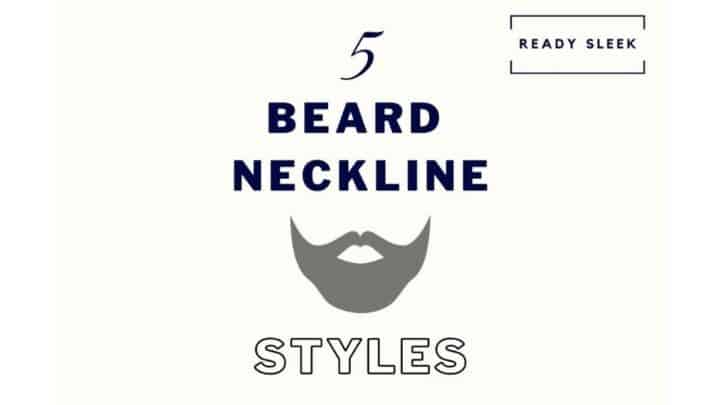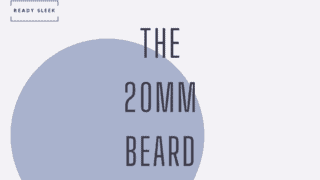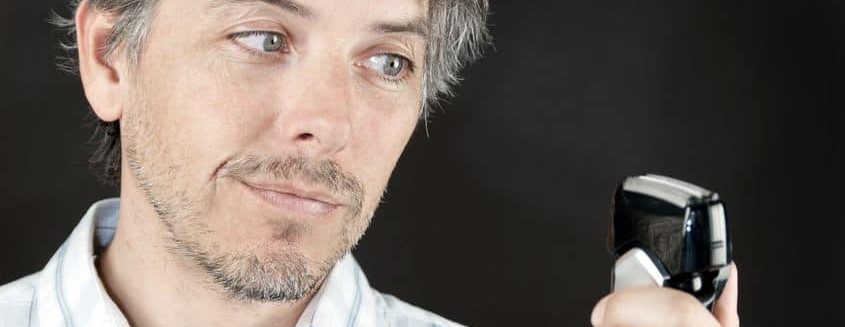Neckline trimming is one of the core pillars of beard grooming, but not all necklines are the same or equally suited to all men. There are differences. You’re about to learn everything you need to know about the beard neckline styles you can choose from.
Although it may sound simple enough, a neckline that’s too high, too low, or simply the wrong shape for your face can definitely look awkward.
It may not be the first part of the beard that comes into view, but a bad neckline can definitely be obvious – particularly from a side-profile.
Before showing you five great neckline styles you could potentially choose from, it’s important to really understand what a neckline actually is and why it’s so important.
Let’s get to it.
What Is A Beard Neckline?
The beard neckline is the lower border of the beard. It’s the border between the neck hair and the neck skin.
Ensuring the neckline is well-defined and set at the correct height is an important aspect of grooming a beard.
A neckline that’s too high can look odd – often leading to an almost double-chin appearance, particularly from side-on.
Necklines that are too low can look untidy, almost as though they hadn’t been trimmed in the first place.
But the question is – do you really need to trim a neckline?
Yes. Neck stubble and neckbeards are generally considered universally unattractive. It almost always looks untidy and badly-kept.
Trimming a neckline is the most effective way to ensure the neck hair ends at the correct height and any hair underneath it is removed.
In general, the shorter the beard, the more important it is to define the neckline. Stubble necklines are crucial because the hair is so short that the neckline is always clearly in view.
With longer beards, it isn’t quite as important. This is especially the case when the beard is long enough to cover the neckline in any case.
How High Is The Average Neckline?
Most beard necklines look best when they vaguely follow the angle of the jawline, with the lowest point being approximately two finger-widths above the Adam’s Apple.

Some men may prefer their neckline a little higher or a little lower. But in general, this level will work for most men and is a pretty safe bet.
Another method that’s commonly used to trim a beard neckline is the double chin method. This will lead to a more rounded neckline than you may like, however.
Having said this, there are variations in neckline style you should be aware of. Let’s go through them.
5 Great Beard Neckline Styles
Here are some classic and common neckline styles you can consider for yourself. The differences between them are subtle yet significant.
Enjoy.
1. Rough And Rugged

Here’s an example of a medium-length beard neckline that’s clearly been defined, but left quite rough and natural-looking.
The lines aren’t sharp, but they’re there.
It isn’t perfect or carefully-sculpted, but that’s intentional. There’s something pretty masculine about imperfection.
This “rough and rugged” style neckline is better suited to medium-length or longer beards which have some fullness. When you’ve got this sort of length, you don’t really need to be as precise with the neckline.
In contrast, stubble beards and short beards usually look better with necklines that are more carefully lined up.
Having said this, as you can see from the photograph, the neckline shape may be more natural-looking but the neck hair beneath it has been properly shaved off.
So, it still looks tidy.
2. Gently Rounded

As I mentioned earlier, most necklines work well when the lowest point is around two finger-widths above the Adam’s Apple.
The neckline should slant upward in both directions, roughly following the angle of the jawline.
But this does leave some scope for experimentation.
It could be more curved or “U-Shaped”, or it could be more “V-shaped”.
V-shaped necklines aren’t exactly in the shape of a V, as the lowest point shouldn’t have a sharp, angular edge. It’s just that the line more closely follows the angle of the jawline on either side.
The photograph above is an example of a more rounded or “U-shaped” neckline. The question is, how do you decide between a U-shaped and a V-shaped neckline?
V-shaped necklines can add sharper angles and more definition to the jawline. Because of this, they’re particularly useful for men with rounder faces or weaker chins.
U-shaped necklines are better suited to men who prefer a more relaxed neckline. It’s worth experimenting with both to see which one you prefer.
3. Jawline-Hugging

I call this type of neckline “jawline-hugging” because it “hugs” the jawline. In other words, it closely follows the jawline on either side, almost looking like it wraps underneath it.
Essentially, they’re more V-shaped than U-shaped for this reason.
If you’re looking to add definition to the jawline, this is ideal. It almost always looks sharp and neat.
It can take some practice ensuring it’s set at the correct height – not too high and not too low. But once you’ve done it a few times, you’ll have a pretty good idea of what looks good and what doesn’t.
The “two finger-width rule” is a pretty good one to follow.
Assess the neckline from both side-profiles and try to ensure it follows the angle of the jawline as closely as possible.
4. High Neckline

This neckline works but is a little riskier. The main risk is that the neckline looks too high.
It’s about as high as the neckline can go. Keeping it high like this is a good option for men who hate neck hair and want to shave most of it off.
But how do you know if your jawline is simply too high? Here’s a good rule-of-thumb you can follow:
Look at your beard from the side-on and open your mouth wide. If the neckline creeps above the jawline and is now on your cheek, it’s too high.
This can look very awkward and can lead to a double-chin appearance, particularly when talking and opening your mouth.
So, re-trim the neckline and repeat the process to ensure it isn’t too high.
5. Au Naturale

OK – this one may not be a “style” as such, but it’s important to recognize that it’s an option.
It’s possible to not have a recognizable neckline and still look good. I mean, it’s risky – but it’s possible. When done properly it can look laid-back, yet reasonably tidy.
The key is to not let the neck hair crawl down too low.
There isn’t much shape to the neckline, but there is still an attempt to ensure the neck hair doesn’t grow out of control.
In many ways, it’s harder than simply trimming a proper neckline like in the examples above. This “tidy yet untidy” look is a difficult one to master.
But if you’re feeling adventurous, try it out. Just make extra efforts to make sure it doesn’t grow out of control.
Short Beard Neckline Vs Long And Full Beard Neckline
Short beard neckline styles generally have to be more carefully set and defined than long and full beard neckline styles.
This is because short beard necklines (and stubble necklines) are simply more visible. When a beard is long enough to cover most of the neckline up, it’s less visible and you can afford to be a little more relaxed with it.
But most serious beardsmen will make a point to tame their neckline, no matter how long or full it may be.
Conclusion
Hopefully, you’ve gotten a better idea of what makes a good beard neckline and also what style options are available to choose from.
As you can see, there’s no such thing as “the perfect neckline”. What works for one bearded man may not work quite as well for another.
Experimentation is key. Try them out for yourself and see which one you prefer.
Enjoy.
Ready Sleek founder. Obsessed with casual style and the minimalist approach to building a highly functional wardrobe. Also a fan of classic, vintage hairstyles.







